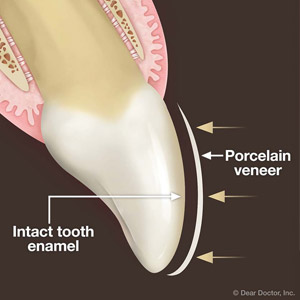Porcelain veneers are positive proof that unattractive teeth don’t always require an intensive restoration to regain their beauty. These thin layers of translucent porcelain — custom-designed and color-matched to blend with your other teeth — are permanently bonded to the visible side of your front teeth.Although they can’t remedy every tooth defect, they’re well suited for mild to moderate disfigurements like chipping, staining or gaps. There are now two types of porcelain veneers: the traditional veneer and the “no-prep” veneer.The standard veneers require some tooth structure removal, referred to as “tooth preparation.” This is because although they’re a millimeter or less in thickness, they can still appear bulky if bonded to an unprepared tooth. To accommodate their width, it’s necessary to remove some of the tooth enamel. This permanently alters the tooth so that it will need some form of restoration from that time on.In recent years, however, other veneer options have emerged that reduces — or even eliminates — this tooth alteration. No-prep veneers are so thin they can be applied to a tooth with virtually no preparation. A more common option, minimal-prep, requires only a minor reshaping with an abrasive tool to ensure the fitted veneer looks as natural as possible. Because of their thinness, these veneers also don’t have to fit under the gum line like standard veneers.To obtain no- or minimal-prep veneers, your tooth enamel needs to be in good, healthy shape. They’re also best suited for people with small or worn teeth, narrow smiles (the side teeth can’t be seen from the front), or slightly stained or misshapen teeth.Because there’s little invasiveness, these low preparation veneers won’t typically create tooth sensitivity and they can often be applied without any form of anesthesia. And because tooth structure isn’t removed, they can be “uninstalled” to return to your natural look. Of course, that’s not always an easy process since the bonding between veneer and the enamel is quite strong, although today’s lasers can be used to detach the veneer quite easily.If you’d like to consider these minimally invasive veneers, talk with your dentist. If you’re a good candidate, you may be able to gain a new smile without much change to your natural teeth.If you would like more information on how veneers can change your smile, please contact us or schedule an appointment for a consultation. You can also learn more about this topic by reading the Dear Doctor magazine article “No-Prep Porcelain Veneers.”
Recent Posts
- The Importance of Emergency Dental Care: Timely Intervention is Key
- Delaying Wisdom Teeth Extraction Can Lead to Serious Issues
- Can an Abscessed Tooth Kill You? Symptoms and When to Seek Urgent Care
- How to Recognize and Effectively Treat a Dental Emergency
- Gum Disease and Heart Disease: Understanding the Connection

